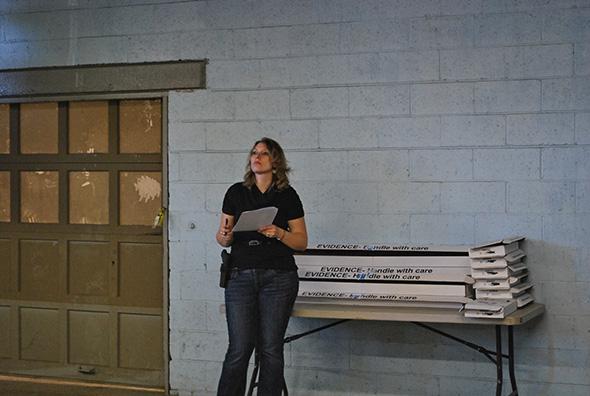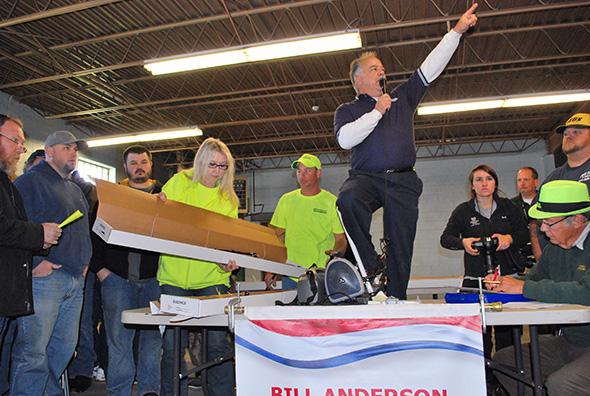GREENSBURG, Pennsylvania—The garage of the Westmoreland County Public Works Department is packed elbow to elbow. On this November Saturday, it’s a sea of camo and flannel, wool and leather, punctuated by black-and-gold caps and sweatshirts—the colors of Pittsburgh’s pro sports teams. Two lines move slowly, one inside and the other outside a U-shaped formation of folding tables. Each is topped by an array of guns. The weapons that have one thing in common: Each one was used to take a person’s life.
A man picks up a revolver and flips open the cylinder, rolling it with his thumb. Another lifts up a rifle and looks through its scope. Eventually, someone notices the other items being sold today: a few bicycles, a pile of photography equipment, a table saw. A middle-aged man in a Steelers cap and red sweatshirt points to the latter object and asks his buddy, “What do you think that’s doing here? Did someone kill himself with a saw?”
The answer is no—the saw is just a surplus piece of equipment the county happens to be selling at today’s auction. As for the 97 firearms on offer, all of them had been left in the possession of the Westmoreland County, Pennsylvania coroner’s office. This isn’t a common occurrence: It took the coroner three decades to accumulate all of these guns. The money raised from this auction will go to the county’s general fund. Of these 97 firearms, “one or two [were used in] accidental deaths, the vast majority in suicides,” explains the county’s coroner, Kenneth Bacha. Each gun on display sits in an open-top box marked, “EVIDENCE - Handle with care.” The case numbers have been scratched out with a marker.
As his assistant holds up each gun, Bill Anderson stands on a table and hawks it with an auctioneer’s breathless patter. “Lot number seven! Lot number seven! That’s your Ruger Security Six! Ruger Security Six!” he shouts. The assistant takes a revolver out of its evidence box and raises it above her head. “Ready to go! Hand money! Hand money! Hand dollars! Ga-ga-ga-ga-ga-ga-ga! A hundred and fifty! A hundred and fifty! Fifty! Now two! Fifty! Two-fifty! Fifty! Now three!” The Security Six eventually goes for $600.

Photo by Nick Keppler
According to the Centers for Disease Control and Prevention, each year about 20,000 people in the U.S. commit suicide using a gun. Bacha says about 20 of those deaths take place in Westmoreland County. Judging by the inventory here, these self-inflicted gunshot wounds come from common American weapons: Marlins, Savages, Smith and Wessons. There’s a mix of handguns and long guns on display, with more than a few small, cheap Saturday night specials. There’s also a 1942 Hungarian military rifle. It sells for $275.
The bidders here say they aren’t concerned about the guns’ histories. “I think there is a darker stigma to it than there really should be,” says Jeremy McClintock, an Army veteran who purchases a .22-caliber Marlin for $125 and a .32-caliber H&R for $160. Suicide is “really unfortunate, but to leave things like that to sit forever and ever and ever is a waste of resources.”
“Guns don’t kill people; people kill people, so it’s not the gun, you know?” says Lera Konovich, whose family bought four guns at the auction. “Auctions like this raise money [so that] our taxes won’t be raised in the future.” Her adult son, Todd Stotsky, says, “I wish they had a background story, but I plan on making up my own.”
One of the few people in the room who would rather these guns not be put up for sale is the man who organized the event. Bacha, the coroner, says he tries to ensure that police have the weapon in their possession at the end of every investigation into a gun fatality. In Pennsylvania, police have the legal authority to destroy such weapons. Coroners do not. But in 97 instances over the last 30 years—since Westmoreland County’s last sale of this kind—the gun stayed with the coroner. Maybe the police forgot to pick it up, or the case was a clear-cut suicide that didn’t get much attention from the cops. Within a year of the suicide, the gun can be claimed by family, but usually it isn’t.
Once a county office has a piece of property of any monetary value—whether it’s a van, a piece of office furniture, a table saw, or a gun—state law mandates that it be used or sold. Bacha, the Westmoreland County coroner since 2002, says he waited to hold this auction until enough guns accumulated. He decided it was time when his office moved into a new building.
Gregory Davis, president of the National Association of Medical Examiners, says he’s never heard of an auction of guns held by a coroner’s office. Attorney Susan Shanaman, solicitor for the Pennsylvania State Coroners Association, says the Westmoreland County sale is the only auction of suicide and accidental fatality weapons that she’s aware of in Pennsylvania. “While in days gone by, there may have been the practice of building up these store rooms of weapons, most coroners these days have pretty good systems of making sure the guns go to the police to destroy,” she says.
Everyone who buys a gun here seems happy that Westmoreland County didn’t destroy the weapons. Many bidders say they got great deals—$100 off the retail price—even if others in the crowd do sometimes shake their heads and whisper their doubts as the bids inch upward.

Photo by Nick Keppler
After the sale, the crowd gets into lines again, this time to fill out forms provided by employees of the auction house. After a background check, they can pick up their guns at Bullseye Firearms Gun Vault, a local dealer.
Anderson, the auctioneer, says he’s overseen countless gun sales, but this is his first of guns collected from death scenes. Though he was the picture of fast-talking auctioneering bluster during the event, he says that he “had a rough night” after appraising each gun at the coroner’s office a few weeks ago. “I was filled with a lot of thoughts and emotions,” he says. “I kept thinking, ‘Those were 97 lives.’ ”
On Saturday, Nov. 8, the weapons used to end those 97 lives netted $24,035 for Westmoreland County.
